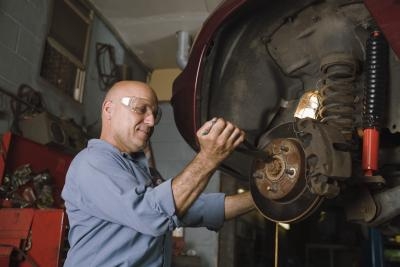
The brake booster, also called the brake assist, works off of intake manifold vacuum to compress an interior diaphragm. When you step on the brake pedal the booster diaphragm activates a pushrod that shoves the brake master cylinder piston inward, forcing brake fluid through the lines with high pressure. The booster increases your foot pressure to force the brake fluid into the calipers and wheel cylinders, which in turn collapse the brake pads, or expand the shoes. The gap between the brake booster pushrod and the master cylinder piston can be adjusted. If not adjusted properly, dragging brakes or a low pedal can result.
Place the vehicle in park or neutral, according to your transmission type. Set the emergency brake for now. Raise the hood and disconnect the negative battery cable with a socket. Take a steel ruler and place it on the floorboard directly under your brake pedal. Align the ruler with the edge of the brake pad in an upright position.
Gently push down on the brake pedal and note how far the brake pedal travels before it meets resistance. The travel length represents your brake pedal free-play distance. Remember the distance or write it down. A comfortable travel distance will be about 1 1/2 inches or so, or according to your specifications in your repair manual -- check your manual.
Raise the hood and locate the brake master cylinder that bolts to the large canister on the firewall. The large canister denotes the brake booster. Use a socket and wrench to loosen and remove the two bolts that hold the master cylinder to the brake booster.
Gently pull the master cylinder back and have an assistant help you secure it temporarily in place with bungee cords. Be careful not to bend the brake lines on the master cylinder. This will allow you room to make the adjustment on the rod protruding from the brake booster.
Have your assistant gently apply the brakes to force the push rod out of the booster so you can see the adjusting nut. Remember your free-play travel length on your brake pedal. If it measured over two inches you will need to extend the push rod length.
Use pliers to hold the push rod and an end wrench to loosen the push rod adjusting nut. Turn the rod outward (counterclockwise) only a few turns, then tighten the lock nut. This will decrease the free-play.
Turn the rod inward to increase the free-play in the brake pedal. Then tighten the lock nut. Place the master cylinder back on the booster and screw the nuts in by hand. Tighten the nuts with a socket and wrench.
Use the ruler to recheck your brake pedal free-play distance. If within specifications, keep it there. If still not within specifications, remove the master cylinder again and repeat the adjustment process. When finished, remove the bungee cords and reconnect the negative battery cable with a socket.